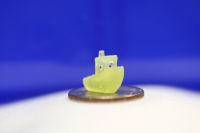The 3D printer has come a long way since the debut of consumer-friendly printers in the early 2000s. The versatile technology allows designers and engineers to forgo traditional manufacturing, opening up a world of seemingly endless possibilities. But the instrument has its limits. The process can be slow, and most objects can only be built layer by layer – with just one material at a time.
Stanford University researchers are challenging the limitations of current 3D printing technology. One innovative printing method is increasing printing speeds by 10x that of the quickest available model and allowing researchers to introduce multiple materials at once. Another group of engineers is using light to carve intricate designs into stationary mounds of resin, hoping to eliminate the need to build from the bottom up.
From creating surprisingly strong nanoscale lattices built to protect fragile satellites to fashioning heart tissue from living cells to combat congenital heart disease, these researchers are exploring the what ifs of this technology. What if our products were more resilient? What if we used biomaterials? And what if we take a moment to consider the inevitable questions that will arise as we move forward with this emerging technology?













